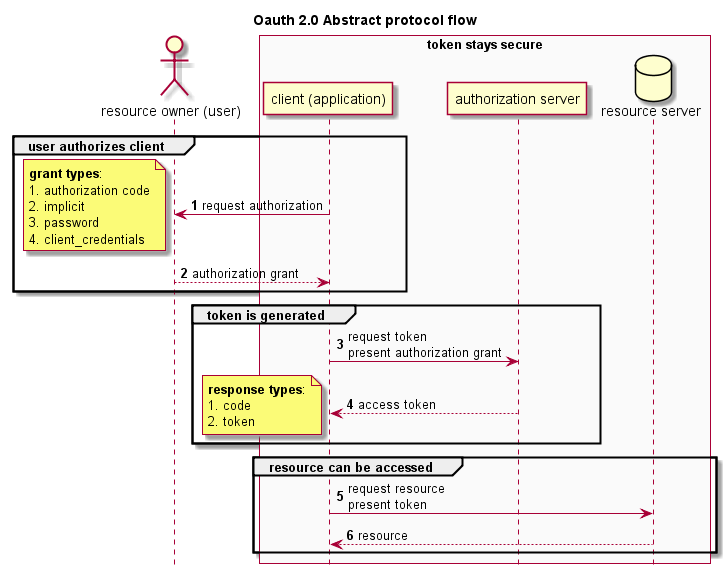使用Emacs创建OAuth 2.0的UML时序图

看起来 OAuth 2.0 框架 已经越来越广泛地应用于 web (和 移动) 应用。太棒了!
虽然协议本身并不复杂,但有很多的使用场景,流程和实现可供选择。正如生活中的大多数事物一样,魔鬼在于细节之中。
在审查 OAuth 2.0 实现或编写渗透测试报告时我习惯画出 UML 图。这方便让人理解发生了什么事情,并发现潜在的问题。毕竟,一图抵千言。
使用基于 GPL 开源协议 Emacs 编辑器来实现,再加上基于 GPL 开源协议的工具 PlantUML (也可以选择基于 Eclipse Public 协议的 Graphviz ) 很容易做到这一点。
Emacs 是世界上最万能的编辑器。在这种场景中,我们用它来编辑文本,并自动将文本转换成图片。PlantUML 是一个允许你用人类可读的文本来写 UML 并完成该转换的工具。Graphviz 是一个可视化的软件,这里我们可以用它来显示图片。
下载 预先编译好了的 PlantUML jar 文件,Emacs 还可以选择下载并安装 Graphviz。
安装并启动 Emacs,然后将下面 Lisp 代码(实际上是配置)写入你的启动文件中( ~/.emacs.d/init.d ),这段代码将会
- 配置
org-mode(一种用来组织并编辑文本文件的模式) 来使用 PlantUML - 将
plantuml添加到可识别的org-babel语言中 (这让你可以在文本文件中执行源代码) - 将 PlantUML 代码标注为安全的,从而允许执行
- 自动显示生成的结果图片
;; tell org-mode where to find the plantuml JAR file (specify the JAR file) (setq org-plantuml-jar-path (expand-file-name "~/plantuml.jar")) ;; use plantuml as org-babel language (org-babel-do-load-languages 'org-babel-load-languages '((plantuml . t))) ;; helper function (defun my-org-confirm-babel-evaluate (lang body) "Do not ask for confirmation to evaluate code for specified languages。" (member lang '("plantuml"))) ;; trust certain code as being safe (setq org-confirm-babel-evaluate 'my-org-confirm-babel-evaluate) ;; automatically show the resulting image (add-hook 'org-babel-after-execute-hook 'org-display-inline-images)
如果你还没有启动文件,那么将该代码加入到 ~/.emacs.d/init.el 文件中然后重启 Emacs。
提示:Control-c Control-f 可以让你创建/打开(新)文件。Control-x Control-s 保存文件,而 Control-x Control-c 退出 Emacs。
这就结了!
要测试该配置,可以创建/打开( Control-c Control-f )后缀为 .org 的文件,例如 test.org . 这会让 Emacs 切换到 "org-mode" 并识别 "org-babel" 语法。
输入下面代码,然后在代码中输入 Control-c Control-c 来测试是否安装正常:
,#+BEGIN_SRC plantuml:file test.png @startuml version @enduml ,#+END_SRC
一切顺利的话,你会在 Emacs 中看到文本下面显示了一张图片。
注意
要快速插入类似 #+BEGIN_SRC 和 #+END_SRC 这样的代码片段,你可以使用内置的 Easy Templates 系统:输入 <s 然后按下 TAB,它就会自动为你插入模板。
还有更复杂的例子,下面是生成上面图片的 UML 源代码:
,#+BEGIN_SRC plantuml:file t:/oauth2-abstract-protocol-flow.png @startuml hide footbox title Oauth 2.0 Abstract protocol flow autonumber actor user as "resource owner (user)" box "token stays secure" #FAFAFA participant client as "client (application)" participant authorization as "authorization server" database resource as "resource server" end box group user authorizes client client -> user:request authorization note left ,**grant types**: # authorization code # implicit # password # client_credentials end note user --> client:authorization grant end group token is generated client -> authorization:request token\npresent authorization grant authorization --> client:var:access token note left ,**response types**: # code # token end note end group group resource can be accessed client -> resource:request resource\npresent token resource --> client:resource end group @enduml ,#+END_SRC
你难道会不喜欢 Emacs 和开源工具的多功能性吗?
